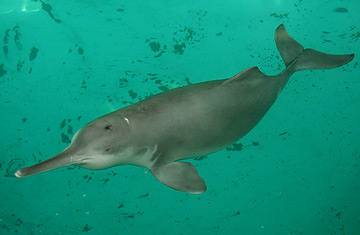Giant Otter
The Giant otter is one of the rarest freshwater otter species and they grow to a size of a massive one and a half a metre length, not including the tail. These large creatures live in Brazil, Guiana. Small but dying populations also inhabit Argentina and Uruguay.
The Giant Otter is about 2,1 metres long, including the tail, which makes him a real giant, comparing to the one and half a meter long European Otter. This sea predator weighs around 22-32 kg, the fur is soft and quite long, while the body itself is massive and muscular. The tail is flattened by the end, which helps the Otter to swim, while the forefeet are not used at all while swimming and they can grab and hold prey.
Usually four to eight Giant Otters live together in a group, hunting, resting and sleeping together. The group usually has one bare area near the river where they rest and each group also digs a system of underground tunnels. Unlike most water mammals, the Giant Otters are extremely agile on both land and in the water. They can stay underwater for up to 30 seconds and they dive about three metres deep.
The lifestyle of the Giant Otter is connected to the rain seasons and water levels in the basins. In the dry period, these otters live in the muddy water of the brooks that haven’t dried out, while from April to September, they live deep in the jungle, which is flooded during this time. If given choice, the Giant Otter chooses slow flowing rivers with plenty of vegetation and fish, as well as cover from the natural enemies – the jaguar and puma.
Giant Otter divides its day, making time for both rest and hunting. This animal can eat up to 4 kilograms of fish, crustaceans and frogs per day. The Otter catches slow fishes, for instance small Catfish that stay at the bottom of the river basin, waiting for a prey. Giant Otter can find the well masked fish by the sensitive whiskers that sense any movement in the water. It’s interesting that the animal travels along with the catfishes and where there is a catfish, there certainly is an Otter.
These animals mate in the water. The mating period is not strictly set, although it mostly happens June through august. The gestation lasts for 9-10 weeks and two to three blind and helpless pups are born. The female is dominant in the pair’s relationships and she’s the one who most often takes care of the offsprings. The young Otters stay with their parents until the mother becomes pregnant again, that is, around a year. Giant Otter life expectancy is about 12 years in the wild.





